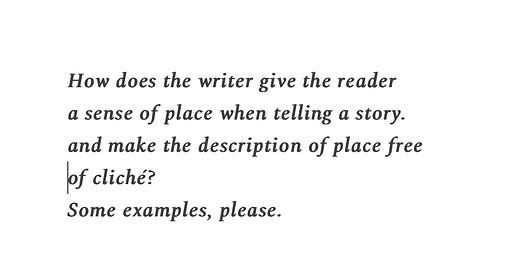“Fiction is properly at work on the here and now; for in novels we have to be there.” Eudora Welty, “Place in Fiction”
Today’s question comes from Elizabeth Bobrick
How does the writer give the reader
a sense of place when telling a story.
and make the description of place
free of cliché? Some examples, please.
Elizabeth Bobrick, professor at Wesleyan University, teaches college students and also incarcerated adults and other adults in her community who ‘always wanted to write.’ She wants to help them understand how to create setting in stories.
We all know that piling on details creates a writing mess. So what to do?
Here’s what I think: Readers understand characters, to some extent, by where they live—even if the names of places are fictionalized as Faulkner does with his mythical town and county of “Yoknpatawpha” and “Jefferson” in As I Lay Dying.
So that we don’t pile on details, we need to tie the “setting” detail to the character and the conflict that’s always the strong stake in a short story, novel or memoir.
Here’s an example: Pam Houston in her short story “The Best Girlfriend You Never Had” (Best American Short Stories) does this in her first sentence: “A perfect day in the city always start like this: my friend Leo picks me up and we go to a breakfast place called Rick and Ann’s where they make red flannel hash out of beets and bacon, and then we cross the Bay Bridge to the gardens of the Palace of the Fine Arts to sit in the wet grass and read poems out loud and talk about love.”
Houston swiftly places us in San Francisco, give us two characters—Leo and the “I” of the story and the fact that “finding love” is the strong stake of the story. She’s also made clear that this is the first-person teller’s story. That’s a whole lot to get done in one sentence.
One defining piece of architecture—the Bay Bridge—gives us the setting that Houston builds on as the story proceeds.
But, we don’t have to begin with place, as in prosaically, “In Baltimore in 1990 … ”—though we can do that, too.
We also do it through vernacular, the way folks talk.
In James Joyce’s tome of a novel Ulysses that takes place on one day, June 16th, in Dublin, Ireland, Joyce begins with “Buck Mulligan”, an Irish name, and the word “kinch” short for “kinchin” used as slang for “child,” and we’re in Martello Tower in Sandycove, but he hasn’t identified the tower by name—or even Dublin until about line 83 where Stephen (Dedalus) looks out at a mailboat at the harbourmouth of Kingstown that is actually known as Dún Laoghaire. He’s swiftly—through names, vernacular and a landmark—placed us in Dublin where the tale takes place.
Eudora Welty helps us understand when she discusses the power of place in her story, “No Place for You, My Love.” She says, “Between the writer and the story she writes, there is the undying third character.” — and she means “place.”1
Here’s an example from that marvel of a story where she’s direct in the first paragraph: “The time was a Sunday in summer—those hours of afternoon that seem Time Out in New Orleans.” The story takes two strangers on what ends up feeling as if it’s a sensual experience as they travel further and further south from Bourbon Street in the heat. The setting actually does the work—with no reference to sex.
For new writers, the difficulty of “place” in science fiction is often misunderstood because the bar for verisimilitude gets raised way higher than in realistic fiction.
Michel Faber does a masterful job of this in The Book of Strange New Things—No easy task. He places a character on an imaginary planet called Oasis where nothing is like what it is on Earth, and we have to believe that this place is airless. Here’s an example: “Peter stepped through the sliding door into the air of Oasis …and he did not instantly die, get sucked into an airless vortex …. Instead, he was enveloped in a moist warm breeze, a swirling balm that felt like steam except it didn’t make his throat catch.”
Ray Bradbury, best known, for his science fiction, wrote an unforgettable, fictional tale Dandelion Wine about his childhood, well after writing Fahrenheit 451. Like Faulkner he used a fictional Green Town that doesn’t get named until pretty late in the book—and I’m not even sure how I know that. I found an early mention to setting tied to another character’s dialogue: “I’m the only guy in all Illinois who’s got a snowflake in summer.”
So, “place” can be set in various ways. Here are a couple lines from Dandelion Wine’s first two paragraphs tied to the main character: “It was a quiet morning, the town covered over with darkness and at ease in bed. Summer gathered in the weather, the wind had the proper touch, the breathing of the world was long and warm and slow …. Douglas Spalding, twelve, freshly wakened, let summer idle him on its early-morning stream.”
That novel is a great choice for science fiction writers to start with. It’s like walking through Paris’s Picasso Museum where we see that Picasso understood realistic painting amazingly well before he painted abstractly.
First, stories are inextricably tied to where they take place. Eudora Welty explains:
“Place in fiction is the named, identified, concrete, exact and exacting, and therefore credible, gathering spot of all that has been felt, is about to be experienced, in the novel’s progress. Location pertains to feeling; feeling profoundly pertains to place; place in history partakes of feeling, as feeling about history partakes of place. Every story would be another, and unrecognizable as art, if it took up its characters and plot and happened somewhere else. Imagine Swan’s Way laid in London, The Magic Mountain in Spain, or Green Mansions in the Black Forest. …Feelings are bound up in place.”2
Second, and perhaps more important, that advice, “write what you know,” can be overused and constraining to us writers and our imaginations. In one of my short stories, I place two sisters on what used to be prostitute heaven, the old Baltimore Street in the downtown of that city, known as “The Block.” I know nothing of prostitution and have never actually walked that strip, but it served my story, and I used it.
Here's Welty’s better advice on what “Write what you know” should mean:
“One can only say: writers must always write best of what they know, and sometimes they do it by staying where they know it. But not for safety’s sake. Although it is in the words of a witch—or the more because of that—a comment of Hecate’s in Macbeth is worth our heed: ‘Security is mortal’s chiefest enemy.’ In fact, when we think in terms of the spirit, which are the terms of writing, is there a conception more stupefying than that of security? Yet writing what you know has nothing to do with security: what is more dangerous? How can you go out on a limb if you do not know your own tree? No art ever came out of not risking you neck. And risk—experiment—is a considerable part of the joy of doing, which is the lone, simple reason all writers of serious fiction are willing to work as hard as they do.”3
Let’s look at how Eleanor does exactly this in the novel she’s posting here Judgement of Others:
In chapter one: “Mothers all over West Sussex were making supper.” In chapter 4: “Through the gate in the wall and Petworth Park rolled out in green and misty damp, the rise of parkland trees caught like ghosts lingering in the growing light.” Petworth Park is in West Sussex. And just after that, “He veered right onto the road to Tillington.” And in chapter 6, she uses a characteristic British word “trilby” that I had to look up. “It was the man in the trilby.”
Here’s the link to Eleanor’s post “Dear Elizabeth”.
***
Eleanor and I ask you to remember that these are separate posts (we share the video that I record) but we both hope for comments on EACH of our posts—as they are separate. That’s the gift to us both as we work hard to study and consider each q.
My follow-up email to you, Elizabeth, will follow, as you subscribe to us both. Look for it from my me dot com account.
P.S.: I have a full course that I introduce here—the link is for you to take a gander—it’s free…. https://marytabor.substack.com/p/write-it-how-to-get-started
If you missed our launch post, take a look at Write it! and This Writing Life.
Ask us a question in Comments or Notes (be sure to tag us both). Or direct message me. I’ll get your q. to Eleanor!
Coming next: Linnhe Harrison
Love,
These posts are all FREE: Help me by choosing to pay with this discount. I will love you back!
Eudora Welty, The Eye of the Story
Ibid.
Ibid.





Yes! Too many go short on the locale. Where a character lives is another character.
Great use of examples, Mary! I really enjoyed this and found it very perceptive. Thank you! I especially valued this: "We need to tie the “setting” detail to the character and the conflict that’s always the strong stake in a short story, novel or memoir."